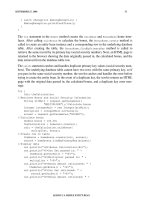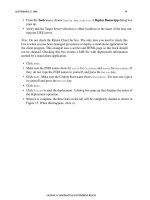Writing Enterprise Applications with Java™ 2 SDK, Enterprise Edition phần 7 pps
Bạn đang xem bản rút gọn của tài liệu. Xem và tải ngay bản đầy đủ của tài liệu tại đây (37.59 KB, 12 trang )
LESSON 4 JAVASERVER PAGES TECHNOLOGY
71 SEPTEMBER 27, 2000
Bonus Calculation
Social Security number retrieved: 777777777
Bonus Amount Retrieved: 200.0
If you supply the same social security number twice, you will see something similar to this:
Bonus Calculation
Soc Sec passed in: 777777777
Multiplier passed in: 2
Error: Duplicate primary key
More Information
Another way to use JavaServer pages technology is in combination with JavaBeans tech-
nology where the JSP page presents a form to the user and calls on the JavaBean to process
the data entered on the form. You can see an example at the following URL:
http://
java.sun.com/j2ee/j2sdkee/techdocs/guides/ejb/html/Client.fm.html#10649
This next URL takes you to an article with a great explanation of JavaServer pages and Java-
Beans technologies: Building Your own JSP Components
/>LESSON 4 JAVASERVER PAGES TECHNOLOGY
72 SEPTEMBER 27, 2000
LESSON 5 ADDING JAVABEANS TECHNOLOGY TO THE MIX
SEPTEMBER 27, 2000 73
Lesson 5
Adding JavaBeans Technology
to the Mix
You can use JavaBeans technology to put a JavaBean between the JSP page and CalcBean
session bean to get a better Model, View, Controller (MVC) separation. MVC is a design
pattern that consists of three kinds of objects. The Model provides the application business
logic, the View is its screen presentation, and the Controller is an object that manages what
happens when the user interacts with the View. A design pattern describes a recurring prob-
lem and its solution where the solution is never exactly the same for every recurrence.
Lesson 4 JavaServer Pages Technology (page 61) is set up so the HTML and JSP pages pro-
vide the screen presentation (View) and manage what happens when the user interacts with
the data (Controller). The entity and session bean (
BonusBean and CalcBean) are the appli-
cation objects or Model.
This lesson uses a JSP page for the screen presentation (View), a JavaBean to manage what
happens when the user interacts with the View (Controller), and the entity and session beans
for the application objects (Model). Separating the Controller from the View like this lets the
JavaBean serve as a wrapper for the session bean and gives the example a much cleaner
MVC separation. An application that uses clear design patterns is easier to update, maintain,
and manage.
• About the Example (page 74)
• Create bonus.jsp (page 76)
• Create the JavaBeans Class (page 79)
• Bean Properties (page 81)
• Remove the WAR File (page 85)
• Create New WAR FIle (page 85)
• Verify and Deploy the J2EE Application (page 86)
• Run the J2EE Application (page 87)
• More Information (page 87)
LESSON 5 ADDING JAVABEANS TECHNOLOGY TO THE MIX
74 SEPTEMBER 27, 2000
About the Example
In Lesson 4 JavaServer Pages Technology (page 61), the application user interface consisted
of an HTML page with an HTML form. The HTML form calls the JSP page when the user
clicks the
Submit button on the HTML page.
Another way to create the user interface is with one JSP page that includes the HTML form,
JSP scriptlets, and JSP-specific tags for interacting with the JavaBean. When the JSP page
loads, the HTML form is displayed and the scriptlet and JSP-specific tags for interacting
with the JavaBean are executed. Because no data has been supplied yet, the display looks
like Figure 17:
Figure 17 When bonus.jsp Loads
After the user enters some data and clicks the Submit button, the HTML form is redisplayed
and the scriptlet and JSP-specific tags for interacting with the JavaBean execute again with
the data supplied. The display looks something like Figure 18. This is because the
ACTION
parameter for the HTML form on bonus.jsp recursively calls itself.
LESSON 5 ADDING JAVABEANS TECHNOLOGY TO THE MIX
SEPTEMBER 27, 2000 75
Figure 18 After User Enters Data and Clicks Submit
If the user enters the same social security number, a duplicate key error is returned and dis-
played on the JSP page as shown in Figure 19.
LESSON 5 ADDING JAVABEANS TECHNOLOGY TO THE MIX
76 SEPTEMBER 27, 2000
Figure 19 Duplicate Key Error
Create bonus.jsp
The code for bonus.jsp is fairly straight forward because the code to look up the session
bean and calculate the bonus is now in the JavaBean. The first part of the file contains the
HTML code to create the form. The code to pass the HTML form data to the JavaBean is in
the second part of the file. The complete
bonus.jsp file appears below. Look it over before
going on to the discussion of its scriptlet and JSP-specific tags for interacting with the Java-
Bean.
<HTML>
<BODY BGCOLOR = "WHITE">
<HEAD>
<TITLE>Bonus Calculation</TITLE>
</HEAD>
<BLOCKQUOTE>
<H3>Bonus Calculation</H3>
LESSON 5 ADDING JAVABEANS TECHNOLOGY TO THE MIX
SEPTEMBER 27, 2000 77
<! ACTION parameter calls this page >
<FORM METHOD="GET" ACTION="bonus.jsp">
<P>
Enter social security Number:
<P>
<INPUT TYPE="TEXT" NAME="SOCSEC"></INPUT>
<P>
Enter Multiplier:
<P>
<INPUT TYPE="TEXT" NAME="MULTIPLIER"></INPUT>
<P>
<INPUT TYPE="SUBMIT" VALUE="Submit">
<INPUT TYPE="RESET">
</FORM>
<! Scriptlet and JavaBeans Tags start here >
<jsp:useBean id = "jbonus" class = "JBonusBean"/>
<%! String sMult, ssec; %>
<%
sMult = request.getParameter("MULTIPLIER");
ssec = request.getParameter("SOCSEC");
%>
<jsp:setProperty name = "jbonus" property="strMult" value="<%=sMult%>"/>
<jsp:setProperty name = "jbonus" property="socsec" value="<%=ssec%>"/>
Social security number retrieved:
<jsp:getProperty name="jbonus" property="socsec"/>
<P>
Bonus Amount retrieved:
<jsp:getProperty name="jbonus" property="bonusAmt"/>
<P>
Error messages:
<jsp:getProperty name = "jbonus" property="message"/>
</BLOCKQUOTE>
</BODY>
</HTML>
LESSON 5 ADDING JAVABEANS TECHNOLOGY TO THE MIX
78 SEPTEMBER 27, 2000
Specify the JavaBean
The following HTML tag specifies the JavaBean being used in this example. The id param-
eter defines an alias to use to reference the JavaBean, and the
class parameter specifies the
JavaBeans class. In this example the
id is jbonus and the class is JBonusBean.
<jsp:useBean id = "jbonus" class = "JBonusBean"/>
Get the Data
The following JSP scriptlets retrieve the user-supplied data from the HTML form input
fields. The multiplier is stored in the
sMult String variable, and the social security number
is stored in the
ssec String variable.
<%! String sMult, ssec; %>
<%
sMult = request.getParameter("MULTIPLIER");
ssec = request.getParameter("SOCSEC");
%>
Pass the Data to the JavaBean
The following HTML tags set two properties in the JavaBean. A property is a private field in
the JavaBean class. The first line uses the
jsp:setProperty name tag to set the strMult
field in the JBonusBean class (aliased by the jbonus id) to the value stored in the sMult
variable. The second line performs a similar operation for the socsec field in the JBonus-
Bean
class.
<jsp:setProperty name = "jbonus" property="strMult" value="<%=sMult%>"/>
<jsp:setProperty name = "jbonus" property="socsec" value="<%=ssec%>"/>
The value="<%=ssec%>" expression sends the data contained in the ssec vari-
able to the socsec field in the JavaBean.
Retrieve Data from the JavaBean
Retrieving data from a JavaBean is similar to sending data to it. You use the jsp:getProp-
erty
name tag and indicate the property (private field) whose data you want to get. The fol-
lowing
getProperty name tag retrieves the data stored in the socsec private field of the
JBonusBean class (aliased by the jbonus id).
Social security number retrieved:
<jsp:getProperty name="jbonus" property="socsec"/>
The following tags perform similar operations for the bonusAmt and message fields in the
JBonusBean class.
LESSON 5 ADDING JAVABEANS TECHNOLOGY TO THE MIX
79 SEPTEMBER 27, 2000
<P>
Bonus Amount retrieved:
<jsp:getProperty name="jbonus" property="bonusAmt"/>
<P>
Error messages:
<jsp:getProperty name = "jbonus" property="message"/>
Create the JavaBeans Class
A JavaBeans class (or bean for short) looks just like any ordinary Java programming lan-
guage class. But to be a bean, a JavaBeans class must follow a set of simple naming and
design conventions as outlined in the JavaBeans specification. Because beans follow the Jav-
aBeans specification, they can be accessed and managed by other programs and tools that
follow the same conventions.
In the Create bonus.jsp (page 76) section, HTML tags and JSP scriptlets are used to get and
set data in the private fields of the
JBonusBean class. This is possible because the JBonus-
Bean
class follows the JavaBeans naming and design conventions.
This section describes the
JBonusBean code and gives you a very simple introduction to Jav-
aBeans technology as it is used with JSP pages. Visit the JavaBeans home page at
http://
java.sun.com/beans/index.html
for further information on JavaBeans technology.
Here is the
JBonusBean class in its entirety. A discussion of its pertinent parts follows.
import javax.naming.*;
import javax.rmi.PortableRemoteObject;
import Beans.*;
public class JBonusBean {
private String strMult, socsec, message;
private double bonusAmt;
CalcHome homecalc;
public JBonusBean() {
try{
InitialContext ctx = new InitialContext();
Object objref = ctx.lookup("calcs");
homecalc = (CalcHome)
PortableRemoteObject.narrow(
objref, CalcHome.class);
} catch (javax.naming.NamingException e) {
e.printStackTrace();
}
}
LESSON 5 ADDING JAVABEANS TECHNOLOGY TO THE MIX
80 SEPTEMBER 27, 2000
public double getBonusAmt() {
if(strMult != null){
Integer integerMult = new Integer(strMult);
int multiplier = integerMult.intValue();
try {
double bonus = 100.00;
Calc theCalculation = homecalc.create();
Bonus theBonus = theCalculation.calcBonus(
multiplier, bonus, socsec);
Bonus record = theCalculation.getRecord(
socsec);
bonusAmt = record.getBonus();
socsec = record.getSocSec();
} catch (javax.ejb.DuplicateKeyException e) {
message = e.getMessage();
} catch (javax.ejb.CreateException e) {
e.printStackTrace();
} catch (java.rmi.RemoteException e) {
e.printStackTrace();
}
return this.bonusAmt;
} else {
this.bonusAmt = 0;
this.message = "None.";
return this.bonusAmt;
}
}
public String getMessage(){
return this.message;
}
public String getSocsec(){
return this.socsec;
}
public String getStrMult(){
return this.strMult;
}
public void setSocsec(String socsec) {
this.socsec = socsec;
}
public void setStrMult(String strMult) {
this.strMult = strMult;
}
}
LESSON 5 ADDING JAVABEANS TECHNOLOGY TO THE MIX
81 SEPTEMBER 27, 2000
Bean Properties
Properties define the data that a JavaBean makes accessible to other programs and tools
through get and set methods. The data might do things such as define the JavaBeans appear-
ance or behavior, or be used in or the result of a series of calculations and computations.
Properties are actually private class fields that should always be private and only accessible
through get and set methods.
The following code segment shows the private properties for the
JBonusBean class. The
JBonusBean class has a corresponding
get<property> method for each field and corre-
sponding
set<property> methods for the strMult and socsec fields.
public class JBonusBean {
private String strMult, socsec, message;
private double bonusAmt;
Constructor
The JBonusBean constructor looks up the session Bean.
public JBonusBean() {
try{
InitialContext ctx = new InitialContext();
Object objref = ctx.lookup("calcs");
homecalc = (CalcHome)
PortableRemoteObject.narrow(
objref, CalcHome.class);
} catch (javax.naming.NamingException e) {
e.printStackTrace();
}
}
Set Methods
JBonusBean has two setter methods (methods prefixed with the word set). Setter methods
set properties (private fields) to specified values. The two setter methods are
setSocsec and
setStrMult for setting the socsec and strMult private fields (JavaBean prop-
erties)
.
In this example, the values used to set the
socsec and strMult properties come from the
setProperty name tags in the JSP page. The J2EE server uses the information supplied in
the following
setProperty name tags to locate the corresponding set methods in the JBo-
nusBean
(aliased by the jbonus id):
LESSON 5 ADDING JAVABEANS TECHNOLOGY TO THE MIX
82 SEPTEMBER 27, 2000
<jsp:setProperty name = "jbonus" property="strMult" value="<%=sMult%>"/>
<jsp:setProperty name = "jbonus" property="socsec" value="<%=ssec%>"/>
In the JBonusBean class, the set<property> methods follow naming conventions so the
J2EE server can map the
setProperty name tags in the JSP file to the correct set<prop-
erty>
methods to pass the data from the JSP page to the JavaBean.
With setter methods, the method name consists of the word
set and the property name. The
property name is the name of one of the
JBonusBean private fields. While field names begin
with a lowercase letter by convention, the second word in a method name is always capital-
ized. So to set the
socsec private field, the method name is setSocsec. The J2EE server
maps the uppercase
Socsec in the method name to the lowercase socsec field. Setter meth-
ods have no return value and have one argument of the appropriate type.
public void setSocsec(String socsec) {
this.socsec = socsec;
}
public void setStrMult(String strMult) {
this.strMult = strMult;
}
Get Methods
JBonusBean has four getter methods (methods prefixed with the word get). Getter methods
get and return property values (private field values). The four getter methods are
getBo-
nusAmt
, getMessage, getSocsec, and getStrMult for returning data from the bonusAmt,
message, socsec, and strMult private fields (JavaBean properties).
In this example, the values used to set the
bonusAmt and message fields come from the get-
BonusAmt
method. The JSP page retrieves data from the JBonusBean properties using the
following
getProperty name tags. The JSP page retrieves only the values it is interested in,
so you might notice that although there is a
JBonusBean property for the multiplier (the str-
Mult
field), that value is not retrieved by the JSP page.
Social security number retrieved:
<jsp:getProperty name="jbonus" property="socsec"/>
<P>
Bonus Amount retrieved:
<jsp:getProperty name="jbonus" property="bonusAmt"/>
<P>
Error messages:
<jsp:getProperty name = "jbonus" property="message"/>









